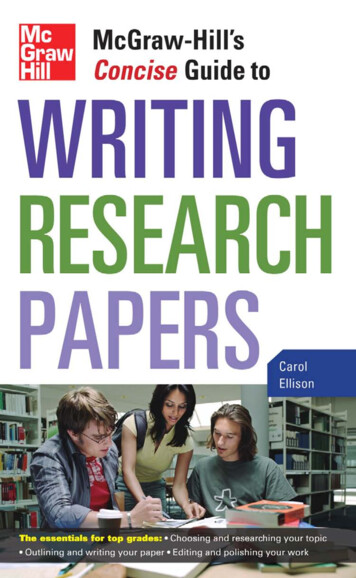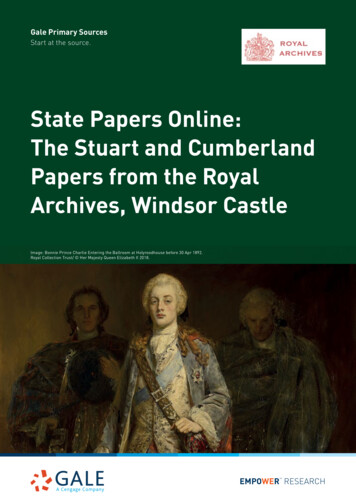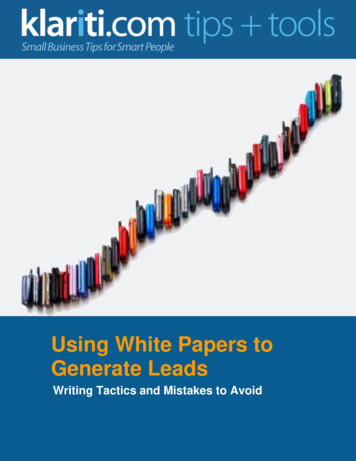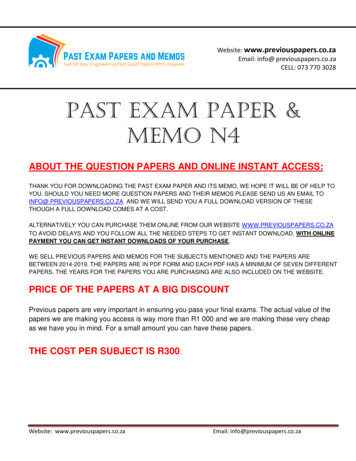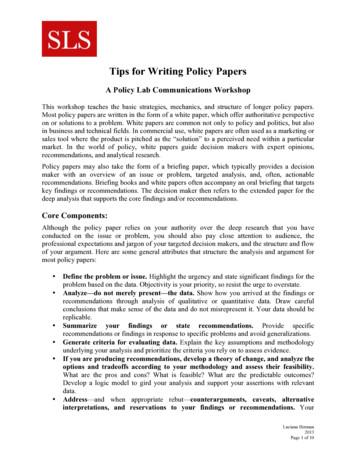
Transcription
Tips for Writing Policy PapersA Policy Lab Communications WorkshopThis workshop teaches the basic strategies, mechanics, and structure of longer policy papers.Most policy papers are written in the form of a white paper, which offer authoritative perspectiveon or solutions to a problem. White papers are common not only to policy and politics, but alsoin business and technical fields. In commercial use, white papers are often used as a marketing orsales tool where the product is pitched as the “solution” to a perceived need within a particularmarket. In the world of policy, white papers guide decision makers with expert opinions,recommendations, and analytical research.Policy papers may also take the form of a briefing paper, which typically provides a decisionmaker with an overview of an issue or problem, targeted analysis, and, often, actionablerecommendations. Briefing books and white papers often accompany an oral briefing that targetskey findings or recommendations. The decision maker then refers to the extended paper for thedeep analysis that supports the core findings and/or recommendations.Core Components:Although the policy paper relies on your authority over the deep research that you haveconducted on the issue or problem, you should also pay close attention to audience, theprofessional expectations and jargon of your targeted decision makers, and the structure and flowof your argument. Here are some general attributes that structure the analysis and argument formost policy papers: Define the problem or issue. Highlight the urgency and state significant findings for theproblem based on the data. Objectivity is your priority, so resist the urge to overstate.Analyze—do not merely present—the data. Show how you arrived at the findings orrecommendations through analysis of qualitative or quantitative data. Draw carefulconclusions that make sense of the data and do not misrepresent it. Your data should bereplicable.Summarize your findings or state recommendations. Provide specificrecommendations or findings in response to specific problems and avoid generalizations.Generate criteria for evaluating data. Explain the key assumptions and methodologyunderlying your analysis and prioritize the criteria you rely on to assess evidence.If you are producing recommendations, develop a theory of change, and analyze theoptions and tradeoffs according to your methodology and assess their feasibility.What are the pros and cons? What is feasible? What are the predictable outcomes?Develop a logic model to gird your analysis and support your assertions with relevantdata.Address—and when appropriate rebut—counterarguments, caveats, alternativeinterpretations, and reservations to your findings or recommendations. YourLuciana Herman2013Page 1 of 10
credibility as a policy analyst relies on your ability to locate and account forcounterargument. You should be especially sensitive to the likely counterarguments that adecision-maker would face in implementing or acting on your recommendations orfindings.Suggest next steps and the implications of the findings or recommendations. Youmay briefly address the feasibility of next steps or explore the implications of youranalysis.Distill the conclusions succinctly in a concluding section and remind the decisionmaker of the big picture, the overall goal, the necessity of the investigation, or of theurgency for action. This answers the “Who cares?” question that reminds the reader ofthe value of the research and recommendations. If you are targeting a decision maker,you should reflect the decision-maker’s primary concerns.Heuristics to Assess Competing Policy Options:The options feasibility charts and the PEST and SWOT matricesAfter you have produced findings on the problem, you must orient the data around likelysolutions. The option and decision feasibility chart and a PESTanalysis can help you locate recommendations in competing data andperspectives.PEST focuses on how political, economic, social, and technologicalfactors affect the feasibility of a policy option. Examples of politicalfactors could include applicable regulations, taxation issues andgovernment policies (which are also sometimes broken out morespecifically as “Legal” factors); they can also be construed as thepolitical interests at stake (which may overlap with social factors).Economic factors include inflation, business cycles, governmentspending, overall cost, and consumer confidence. Social factorsinclude demographics, public attitudes, and income distribution.Technological factors focus on the technology involved in supporting or implementing aparticular option, including energy use and the availability of key technology. PEST analysisinvolves not only identifying the relevant factors, but also considering options for responding tothese influences.Yet, PEST analysis for policy makers is a somewhat fluid heuristic. It simply offers a startingpoint from which you can drill down to increasingly detailed conclusions and recommendations.It may also be broken out as PASTEL, for example: Political, Administrative, Social,Technological, Economic, and Legal factors. You should adapt and prioritize the underlyingcriteria according to your policy needs.The first example chart shows the variability in a strong PEST analysis, breaking it into fivecategories to assess the feasibility of implementing four recommendation options: PoliticalFeasibility, Administrative Feasibility, Equity, Cost Effectiveness, and Environmental Impact.Luciana Herman2013Page 2 of 10
That chart also shows that the policy writer folded Social Feasibility into the Political Feasibilityand Equity tests. The example chart focuses on the problem of pesticides, offering four possiblepolicy options to control farm pesticide use: (1) Do Nothing/Status Quo, (2) Tax Pesticides, (3)Increase Number of Pesticides Banned, (4) Discourage Pesticides through Tax Breaks toEcologically Appropriate Crops, (5) Limit the Number of Pesticides that can be applied to aparticular crop. The chart then assesses the overall positive and negative outcomes or qualitiesassociated with each possible solution to reveal a dominant recommendation: Tax Pesticides.You can build your own Feasibility Chart by measuring options in the context of PESTcategories and through the perspectives of key interest groups. The more detailed yourknowledge of your subject, the more authoritative the outcome of the chart. In this chart, thepolicy writer prioritizes five hypothetical solutions to the problem of pesticide use amongfarmers:OptionsDoNothing/StatusQuoTax PesticidesIncreaseNumber ofPesticidesBannedDiscouragePesticidesthrough TaxBreaks toEcologicallyAppropriateCropsLimit theNumber ofPesticidesUsed onCertain CropsCriteria- -- /- /- /- /--- --- /- /-- /-- /- ityEnvironmental ImpactEconomic Impact/CostEffectivenessThe PEST chart shows that, while all five options have positive environmental impact, only oneof the options predominates among the other criteria. In this policy analyst’s view, taxingpesticides meets the bar of being administratively feasible and equitable to all parties; it has apositive environmental impact and it is both cost effective and offers a positive economic impact.For this policy writer, taxing pesticides is the best recommendation, which she will highlightearly in her memo.You’ll note, however, that the first column—“Political Feasibility”—shows up as the singlenegative for her recommendation of Tax Pesticides. Thus, in the body of her memo, the writerLuciana Herman2013Page 3 of 10
needs briefly to address and rebut or qualify the shortcomings of the political feasibility of taxingpesticides. The writer will also discuss the highlights, tradeoffs, and shortcomings of the otherfindings, demonstrating, for example, the limitations of increasing the number of bannedpesticides and of limiting the amount of pesticides applied to particular crops.A second chart examines the same five possible options through the perspectives of involvedinterest groups.Stakeholders ChartOptionsDoNothing/StatusQuoTax PesticidesIncreaseNumber ofPesticidesBannedDiscouragePesticidesthrough TaxBreaks toEcologicallyAppropriateCropsLimit theNumber ofPesticidesUsed onCertain CropsInterestGroups- --- -- -- - /-- -- /- /- /-The sThe EnvironmentOrganic FarmersFarm LaborThe stakeholders chart shows that, while all five possible options (or solutions to the problem ofunder-regulated and over-used pesticides) have both positive and negative aspects, once again,the solution of taxing pesticides dominates. When the option of “Tax Pesticides” again shows uppositively, the writer can feel certain in prioritizing that recommendation.Should the researcher wish to drill down further into the recommendation of taxing pesticides,she could, for example, compose yet another chart that breaks “Tax Pesticides” into differentcomponents, depending on her overall goals. She might, for example, analyze different types oftaxes for pesticides or, alternatively, break the pesticides into subgroups, taxing them accordingto their virulent effects on people or the environment. The chart is only as authoritative as itscreator but it will focus your attention on possible outcomes or findings. It is a first step inclarifying your ideas before writing the policy paper.Luciana Herman2013Page 4 of 10
SWOT (Strengths/Weaknesses/Opportunities/Threats) Analysis. The SWOT analysis is adaptedfrom organizational management and business strategy. It surveys the surrounding environmentof a specific policy or strategy that you are analyzing or proposing. It allows you to identify theinternal characteristics of the policy as either strengths or weaknesses and classify externalfactors as opportunities or threats.After assessing and classifying internal and external factors, analysts construct a 2-by-2 matrixwith the following four cells: strengths-opportunities (S-O), weaknesses-opportunities (W-O),strengths-threats (S-T), and weaknesses-threats (W-T). You should run each of yourrecommendations through a SWOT analysis.The Executive SummaryOnce you have determined your dominant recommendation/s or findings, you are ready tostructure your white paper or briefing book and write the Executive Summary. The structure ofthe paper or briefing book should build towards your recommendations, not develop thechronology of the problem or research. It can help to write a draft of the Executive Summaryfirst as a structuring device. You will, of course, return to it at the end of the process of writing,revising it in accord with your final analysis.Although the Executive Summary is the most important part of any policy paper, it is often themost difficult to write. Yet there are basic steps that will help turn complex ideas into succinctLuciana Herman2013Page 5 of 10
and powerful arguments guaranteed to capture the attention of a busy reader. You will, forexample, need briefly to describe the current policy situation, offer immediate pros and cons ofyour reasoning for change, and explicitly state your recommendation/s or findings.The Executive Summary serves as a starting point – but also the end point – for the policy paper.It telegraphs your key recommendations, relying on your authority as a researcher or expert inyour field. It not only summarizes your key points for the busy reader, but highlights therecommendations in a memorable way to guide future discussions. Think of it through the lens ofyour decision maker: What key points best prepare your decision maker to remember andunderstand your research and recommendations?As a general rule, the executive summary is no more than 5% of the full length of the paper, so a100-page white paper might have a 5-page executive summary. This is merely a rule of thumb.Your executive summary should be as long as it needs to be to summarize your key points.1) Motivation/problem statement: Why do we care about the problem? What practical,theoretical, legal, sociological, or policy gap does your research address? How does yourwork contribute to the field? How does it intersect—or not—with other scholars’ work inthe field?2) Methods/procedure/approach: What did you do to get your results? What methods didyou use—e.g., developed and analyzed surveys, completed a series of multivariateregressions, analyzed the legislative history of the issue, interviewed stakeholders, etc.3) Results/findings/recommendations: As a result of your analysis, what did youlearn/recommend?4) Conclusions/implications: What are the larger implications of your findings? How dothey help readers understand the problem? How do they help decision makersunderstand/solve the problem? How do they help identify the gap in existing research?Are there next steps in pursuing research on the issue?A useful way to draft your introduction is the journalist’s “Who / What / Why / How” heuristic.WHO and WHAT / Where1. Acknowledges the target audience, the intended use/s, and the expected disseminationfor the paper.2. Concisely states the problem or issue. It may orient the problem in terms of policy.What are the limitations or deficiencies in current policy?WHY3. Offers reasons for initiating research to examine the problem and more fully explainswhy the issue is problematic.4. May sign post key policy options or standard approaches; sometimes this is stated asthe status quo, sometimes it includes existing alternatives that seek to remedy or addressthe problem.Luciana Herman2013Page 6 of 10
5. May sign post the pros and cons of existing approaches or options or may highlight thegeneral trends in addressing the issue.HOW / When6. May reference the methodology used to examine the data or explain core assumptionsthat guided research and analysis.7. States findings or evidence that explore / describe / explain the issue. It may recommendcorrective actions or policies.8. Offers supporting reasons for the analysis of the evidence or for selecting orhighlighting particular actions.9. May conclude briefly with the urgency and opportunity for action.A checklist for drafting the executive summary:1. Are all of the crucial points of your argument covered? Do you prepare your reader forthe analysis ahead? Conversely, if this is all the reader had to refresh her memory afterreading your full analysis would she be adequately equipped to discuss your argument,testify on the issue, or move forward with a policy debate?2. Is there a brief, clear storyline that outlines the big picture?3. How effectively do you summarize the sections ahead? Does the structure of thosesections reveal the right logic for your target audience? Have you framed the issues fromthe perspective of key stakeholders, senior decision-makers, or your target audience?4. How focused is the background description? Beware of wasting space on background.5. Are problems well specified from the perspective of the likely reader(s)? If relevant, areexisting and potential laws, regulations, and current policy interventions covered?6. If you are proposing policy options, do you signpost the tradeoffs involved? Are allproblems matched with potential solutions or guidelines for change? Is the treatment ofadvantages and disadvantages (economically, politically) analytically sound and clearlyexplained?7. Are recommendations and/or findings feasible, clear, and logically prioritized?8. Do you suggest a framework for future work on the issue?9. Is the overall presentation and writing quality up to professional standards? Do you avoidexcessive wordiness?Basic Structure of a Policy Paper1. The Executive Summary.2. Introduction (and Background). These are sometimes broken out as separate sections withthe introduction dedicated to the broad goals and underlying motivations for the paper andthe background allowing a fuller development of the historical rationale and context for theLuciana Herman2013Page 7 of 10
issue. Sometimes they are joined to describe the context for the ultimate goal, the decision tomove forward with research on the topic, or the big picture for the research you areundertaking. This is also where you might highlight your theory of change.3. Methodology. Narrate your methodology briefly. Relegate the micro data, survey questions,and the specific details for your rationale in the appendices.4. Literature Review. Here, you should more fully describe the status of existing academicwork or thinking about the issue and situate your own research in the context of questionsthat still need answers. How does your work or project fit into the overall context of existingresearch or common academic perceptions on the general issue? What scholarlycontributions does your work offer?5. Policy Options or Policy Context. Depending on the orientation of your research, you mayneed to explore the pros and cons of possible policy options. You should always describe thestatus quo of current policy, including current intervention efforts.6. Analysis of Findings or Evidence. This is your original research. You want your argumentto flow logically and fluidly, but be sure to use descriptive headings and subheadings to helpguide and orient the reader.7. Case Studies and Best Practices. If your findings are grounded in original case studies,indicate the names of those case studies individually with “Lessons Learned” at the end ofeach individual case study. Be aware that “Best Practices” demand rigorous analysis and donot flow intuitively from Lessons Learned. If your analysis of the case studies proveslengthy, you might relegate the full details to Annexes and then summarize each with“Lessons Learned” (and, if relevant, “Best Practices”) in the text of the report.8. Policy Options and Recommendations. Again, break these out by specific subheaders.Some policy papers may merge the findings and recommendations, with therecommendations flowing immediately from specific findings. Most, however, present allfindings together in a single section, followed by policy options and recommendations. Justto be clear, it’s okay if your analysis stops short of full recommendations so long as youclearly lay out the relevance for your analysis of the evidence.9. Implementation and Next Steps. Some policy papers fold implementation into therecommendations or into next steps. Others break out this section discretely to detail thespecific steps of how and when to implement the recommendations. If there are significantrisks, costs, or obstacles associated with implementation, you should discuss them in theearlier section that describes the pros and cons of the policy recommendation/s. This sectionshould be dedicated to the mechanics of implementation. Again, your paper may stop short ofdeveloping implementation, but you might acknowledge implementation as a part of “NextSteps.”10. Conclusion. Here, you might return to the big picture or the motive of your analysis: What isthe goal of the analysis or of your policy recommendation/s? What will happen if thedecision-maker does not act on your research or move forward with the recommendation?What will happen if she does? While you do not want to succumb to rhetoric, this is youropportunity to remind your reader of the importance of your analysis.11. Appendices. These typically include the survey data and questions, charts and graphs, anddetails of case studies that gird your analysis.Luciana Herman2013Page 8 of 10
12. Bibliography. While professional white papers may not reference their sources, anyacademic papers must provide a full bibliography in addition to fully cited, footnotedreferences. Footnotes and endnotes, however, are not standard for most white papers.Sample White Papers For Copyright Policy Lab: United States Copyright Office, PRE-1972 SOUND RECORDINGS(12/11), Executive Summary. mmary.pdfCopyright Office, PRE-1972 SOUND RECORDINGS (12/11), Full Report.o pdf Prize-winning policy analysis thesis, Harvard Kennedy School: Mamie Marcus (2007), ImmigrantVoters in Massachusetts: Implications for Political Parties,o http://www.hks.harvard.edu/var/ezp fo This policy analysis paper first highlights the findings, building on them for the subsequentrecommendations. It is far simpler in style, structure, and argument than a Copyright Officewhite paper, but it offers a good starting point for understanding the structure of a standardwhite paper. Prize-winning policy analysis thesis, Harvard Kennedy School: Agustina Schijman and GuadalupeDorna, From Vulnerable Mountaineers to Safe Climbers (2012)o http://www.hks.harvard.edu/var/ezp aid/SYPA Dorna Schijman 2012.pdfo This policy paper offers trenchant insight on the decline of the middle class in Argentina,with actionable recommendations for the government. Following the Introduction, the paperdefines its key terms and describes its methodology. It states clear motivations for theresearch, laid out as goals or objectives. At each step, the authors never lose sight of thepractical and actionable nature of their research and recommendations. Pew Center, Asia Society. January 2009. "A Roadmap for U.S.-China Cooperation on Energy andClimate Change,”o http://www.pewclimate.org/US-Chinao This report presents a vision and a concrete roadmap for U.S.-China collaboration focused onreducing greenhouse gas emissions to mitigate the effects of climate change. The reportbegins with a “Forward” that highlights the importance of a collaboration between the U.S.and China as key leaders in negotiating climate change policy. The Forward also names keygoals and describes underlying motivations.o The Executive Summary explicitly names basic assumptions for the rationale supporting themethodology, findings, and recommendations. Without those assumptions, readers will not bepersuaded of the report’s ultimate recommendations. The Executive Summary then advocatesits major recommendations before moving on to explicit findings with second-level, morespecific recommendations. The conclusion to the Executive Summary underscores theurgency of following its recommendations both in a negative sense—what will happen ifChina and the U.S. do not act on these recommendations—and in a positive sense—what willhappen if China and the U.S. do act on the recommendations. While conclusions are notmandatory for executive summaries, they do allow you to return to the big picture or themotive and urgency of your policy recommendations.Luciana Herman2013Page 9 of 10
ResourcesGeneral Texts on Policy Analysis: Bardach, Eugene. 2000. A Practical Guide for Policy Analysis. New York: Chatham House Publishers. Brest, Paul and Linda Hamilton Krieger, 2010. Problem Solving, Decision Making, and Professional Judgment:A Guide for Lawyers and Policymakers. Oxford UP. Smith, Catherine F. 2010. Writing Public Policy. Oxford UP. Weimer, David L. and Aidan R. Vining. 1992. Policy Analysis: Concepts and Practice. Englewood Cliffs, N.J.:Prentice Hall.Writing Guide: Williams, Joseph. 2008. Style: Lessons in Clarity and Grace.Online Resources Harvard Kennedy School Communications Programo ns-program/The Hume Center for Writing and Speakingo opsThe HKS Policy Analysis Exercise: The Writing Guide:o 12/07/PAE-WRITING-GUIDE-2009.pdf“Advanced Policy Writing for Decision Makers,” HKS communications course (DPI 821M), which focuses onthe production habits, style, and structure for extended white papers and briefing books.o http://isites.harvard.edu/icb/icb.do?keyword k92966“Policy Writing for Decision Makers,” Luciana Herman’s basic policy writing course (DPI 820M), whichteaches basic policy analysis, style, and structure for proposals, memos, and oral briefings.o http://isites.harvard.edu/icb/icb.do?keyword k91384Luciana Herman2013Page 10 of 10
in business and technical fields. In commercial use, white papers are often used as a marketing or . categories to assess the feasibility of implementing four recommendation options: Political Feasibility, Administrative Feasibility, Equity, Cost Effectiveness, and Environmental Impact. Luciana Herman 2013 Page 3 of 10 .







